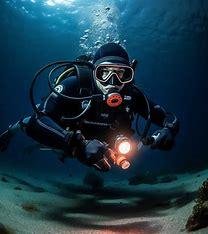Underwater exploration requires the right dive light, and a key factor to consider is the beam angle. The beam angle determines the light distribution, significantly impacting your underwater visibility and experience. In this blog, we’ll explore the best beam angle for dive lights and how to choose the right one for your needs.
Understanding Beam Angles
Beam angle refers to the width of the light beam emitted by the dive light. It is measured in degrees and can range from narrow to wide. Each type of beam angle serves a specific purpose and can greatly affect your underwater experience.

Narrow Beam (6-12 degrees)
A narrow beam angle produces a focused and intense light. This type of beam is ideal for long-range visibility and is particularly useful in clear water conditions where you need to see further into the distance. It can penetrate through murky waters and tight spaces, making it a favorite among technical divers and those exploring underwater caves or wrecks.
Medium Beam (13-45 degrees)
A medium beam angle offers a balanced light spread, making it suitable for general use. This beam type provides a good compromise between distance and coverage, making it versatile for various diving scenarios. Whether you’re navigating open waters or exploring coral reefs, a medium beam angle ensures you have adequate visibility without overwhelming the surroundings.
Wide Beam (46 degrees and above)
A wide beam angle provides broad light coverage, perfect for close-up exploration and underwater photography. It illuminates a large area, allowing you to see more of your immediate surroundings. This beam type is especially beneficial for night diving, marine life observation, and capturing wide-angle underwater shots, ensuring you don’t miss any details in your underwater adventure.
Factors to Consider When Choosing Beam Angles
Choosing the right beam angle for your dive light involves several important factors that can influence your underwater experience.
Diving Environment
The type of water and its clarity are crucial considerations. In clear water, a narrow beam can be highly effective, allowing you to see further into the distance. This focused light can penetrate deeper, providing better visibility. Conversely, in murky or turbid water, a wider beam may be more beneficial. The broader light coverage helps to illuminate a larger area, improving overall visibility in challenging conditions.
Type of Diving
Different diving activities necessitate different beam angles. Technical divers, who often venture into deeper and darker environments, typically prefer narrow beams. These beams offer the intensity needed for long-range visibility and navigation through tight spaces like caves or wrecks. On the other hand, recreational divers, who may be exploring coral reefs or open waters, often opt for medium or wide beams. These beams provide a balanced light spread, enhancing the overall diving experience without overwhelming the surroundings.
Personal Preference
Your comfort and diving style are also significant factors. Some divers prefer a wider beam for better peripheral vision, which can be helpful in spotting marine life or navigating complex environments. Others might favor a narrow beam for focused exploration, allowing them to concentrate light on specific areas or objects. Ultimately, the best beam angle is one that aligns with your diving preferences and needs.
Advantages of Different Beam Angles
Each beam angle of a dive light comes with unique advantages, tailored to specific underwater conditions and activities.
Narrow Beam
A narrow beam angle, typically between 6-12 degrees, provides a concentrated light source. This focused intensity allows divers to see further distances and effectively penetrate the darkness. It is particularly useful for deep dives and technical diving, where visibility is crucial. Narrow beams are also ideal for exploring underwater caves or wrecks, as they can illuminate long, narrow passages without dispersing light widely. This targeted approach helps in navigating and observing distant objects clearly.
Medium Beam
A medium beam angle, ranging from 13-45 degrees, offers a balanced combination of distance and coverage. This versatility makes it suitable for various diving scenarios, from recreational to night diving. The medium beam provides enough light to see a broader area without compromising on depth visibility. It is perfect for divers who want a well-rounded light source that can adapt to different environments, ensuring a safe and enjoyable dive.
Wide Beam
A wide beam angle, typically 46 degrees and above, ensures maximum light coverage. This broad spread is ideal for illuminating large areas, making it perfect for close-up exploration and underwater photography or videography. The wide beam allows divers to capture detailed and expansive underwater scenes, reducing harsh shadows and providing even lighting. It is especially beneficial for observing marine life, as it lights up the surroundings without startling the creatures. For divers focused on capturing the beauty of the underwater world, a wide beam angle is indispensable.
Best Beam Angles for Specific Diving Activities
Selecting the right beam angle for your dive light can significantly enhance your underwater experience, tailored to the specific diving activity you engage in.
Night Diving
For night diving, a medium beam angle, typically around 20-30 degrees, is preferred. This beam angle provides a good balance of distance and coverage, ensuring that divers can see both near and far. The medium beam is ideal for navigating through the dark waters, as it illuminates enough of the surrounding area without overwhelming your vision. This balance helps maintain spatial awareness and avoids startling nocturnal marine life, making the dive more enjoyable and safe.
Cave Diving
Cave diving demands a narrow beam angle, generally between 10-15 degrees. This concentrated light source is essential for penetrating tight spaces and long passages often encountered in caves. The narrow beam provides intense illumination in the direction it is pointed, allowing divers to see further into the darkness and navigate through narrow corridors effectively. It helps in highlighting specific details and obstacles, which is crucial for safe and successful cave exploration.
Photography/Videography
For underwater photography and videography, a wide beam angle of 60 degrees or more is the best choice. This wide spread ensures maximum coverage, capturing expansive scenes and reducing harsh shadows that can obscure details. The broad beam illuminates a large area evenly, making it ideal for capturing the beauty and intricacies of underwater landscapes and marine life. It helps in achieving high-quality, detailed images and videos, enhancing the overall visual documentation of your dive.
Choosing the appropriate beam angle for your specific diving activity ensures that you have the optimal lighting conditions, enhancing both safety and enjoyment underwater.
Top Dive Lights with Optimal Beam Angles
Selecting a dive light with the optimal beam angle can greatly enhance your underwater experience. Here are some top models known for their specific beam angles, catering to different diving needs.
Light & Motion Sola Dive 1200
The Light & Motion Sola Dive 1200 offers a wide beam angle of 60 degrees, making it an excellent choice for underwater photography and general diving. This wide beam provides comprehensive light coverage, illuminating large areas and ensuring that you capture every detail in your photos and videos. It’s particularly useful for night dives and exploring intricate underwater landscapes, where even lighting is crucial for clear visibility and stunning imagery.
Underwater Kinetics SL3 eLED
The Underwater Kinetics SL3 eLED features a narrow beam angle of 10 degrees, ideal for technical and cave diving. This focused beam penetrates deep into the darkness, providing long-range visibility essential for navigating tight spaces and complex underwater environments. The intense, concentrated light helps in identifying distant objects and hazards, making it a reliable choice for divers who require precise illumination in challenging conditions.
Bigblue AL1200WP-II
The Bigblue AL1200WP-II provides a medium beam angle of 85 degrees, offering versatility for various diving conditions. This medium beam strikes a perfect balance between distance and coverage, suitable for recreational divers and night diving. It ensures adequate light spread to illuminate your immediate surroundings while maintaining enough intensity to see further distances. The versatile beam angle makes it a practical and reliable choice for a wide range of diving activities.
Choosing the right dive light with the appropriate beam angle can significantly improve your underwater exploration, ensuring safety, clarity, and an enhanced diving experience.
Conclusion
Selecting the best beam angle for your dive light is crucial for enhancing your underwater experience. By understanding the different beam angles and their specific applications, you can choose the right dive light to suit your needs. A narrow beam is ideal for technical and cave diving, providing focused, long-range visibility. A medium beam offers a balanced light spread, perfect for general use and night diving. A wide beam is best for photography and close-up exploration, ensuring broad coverage and detailed illumination. Whether you’re exploring deep caves, enjoying a night dive, or capturing underwater beauty, the right beam angle will illuminate your adventure perfectly, ensuring safety and enhancing your overall diving experience. Choosing the appropriate beam angle allows you to tailor your dive light to your specific diving activities, making every dive more enjoyable and successful.
FAQs: What is the Best Beam Angle for Dive Light?
What factors should I consider when choosing a beam angle for my dive light?
When choosing a beam angle for your dive light, consider the diving environment, type of diving, and personal preference. Clear water benefits from narrow beams for long-range visibility, while murky water is better suited to wide beams for broader coverage. Technical diving often requires narrow beams, while recreational diving can benefit from medium or wide beams.
What is the best beam angle for night diving?
For night diving, a medium beam angle (around 20-30 degrees) is generally preferred. This provides a good balance of distance and coverage, allowing divers to see both near and far while maintaining adequate illumination of their surroundings without overwhelming their vision.
Which beam angle is ideal for underwater photography and videography?
A wide beam angle (60 degrees or more) is ideal for underwater photography and videography. This ensures maximum coverage and even lighting, helping to capture detailed and expansive underwater scenes while reducing harsh shadows that can obscure details.
Why is a narrow beam angle recommended for cave diving?
A narrow beam angle (10-15 degrees) is recommended for cave diving because it provides focused, intense light that penetrates deep into tight spaces and long passages. This concentrated beam helps divers navigate and see further into the darkness, which is essential for safe and effective cave exploration.
Can a medium beam angle be versatile for different diving conditions?
Yes, a medium beam angle (13-45 degrees) is versatile and suitable for various diving conditions. It offers a balanced combination of distance and coverage, making it ideal for both recreational and night diving. This beam angle ensures adequate visibility without overwhelming the surrounding environment, providing a well-rounded light source for diverse underwater scenarios.
